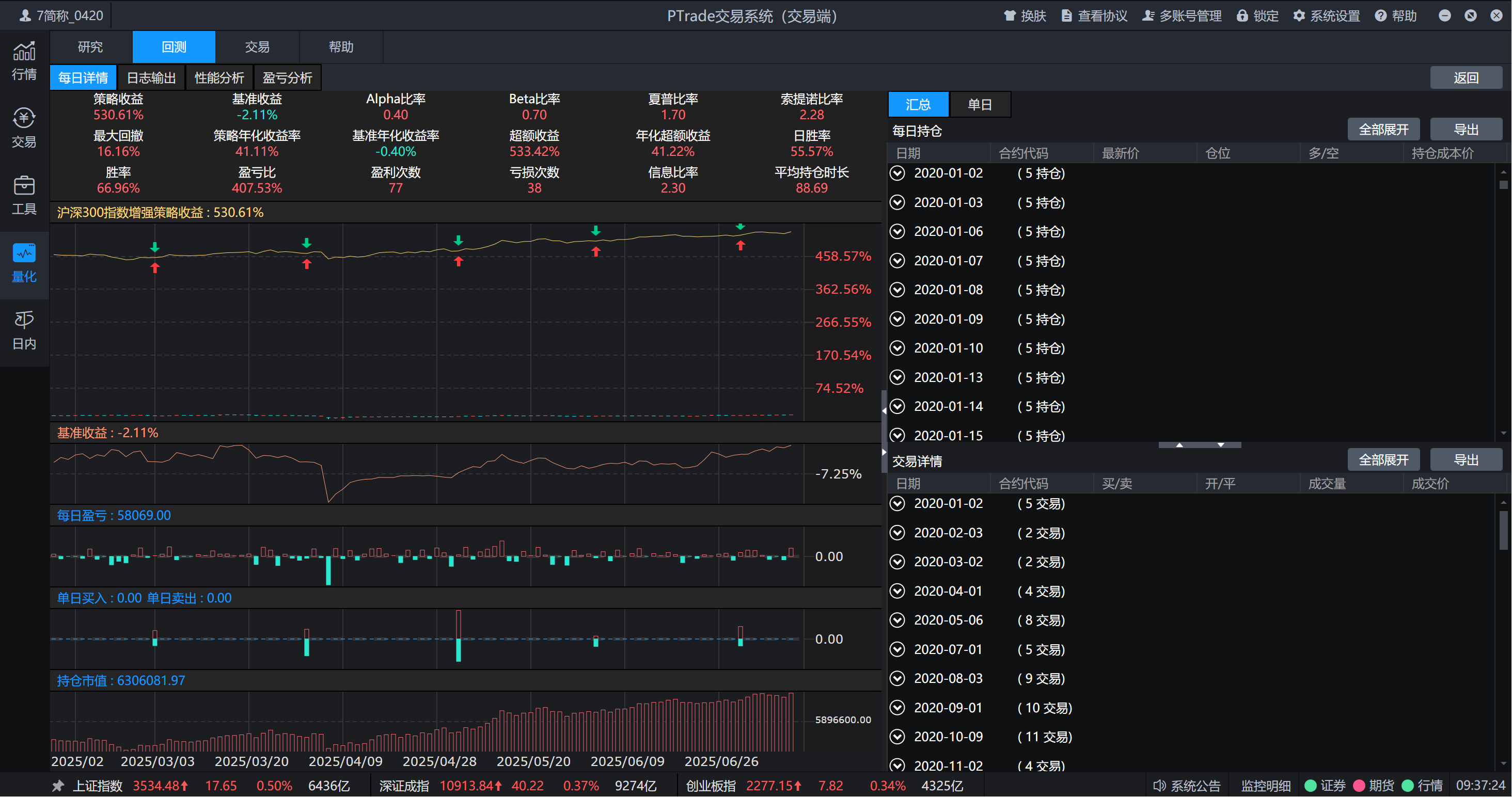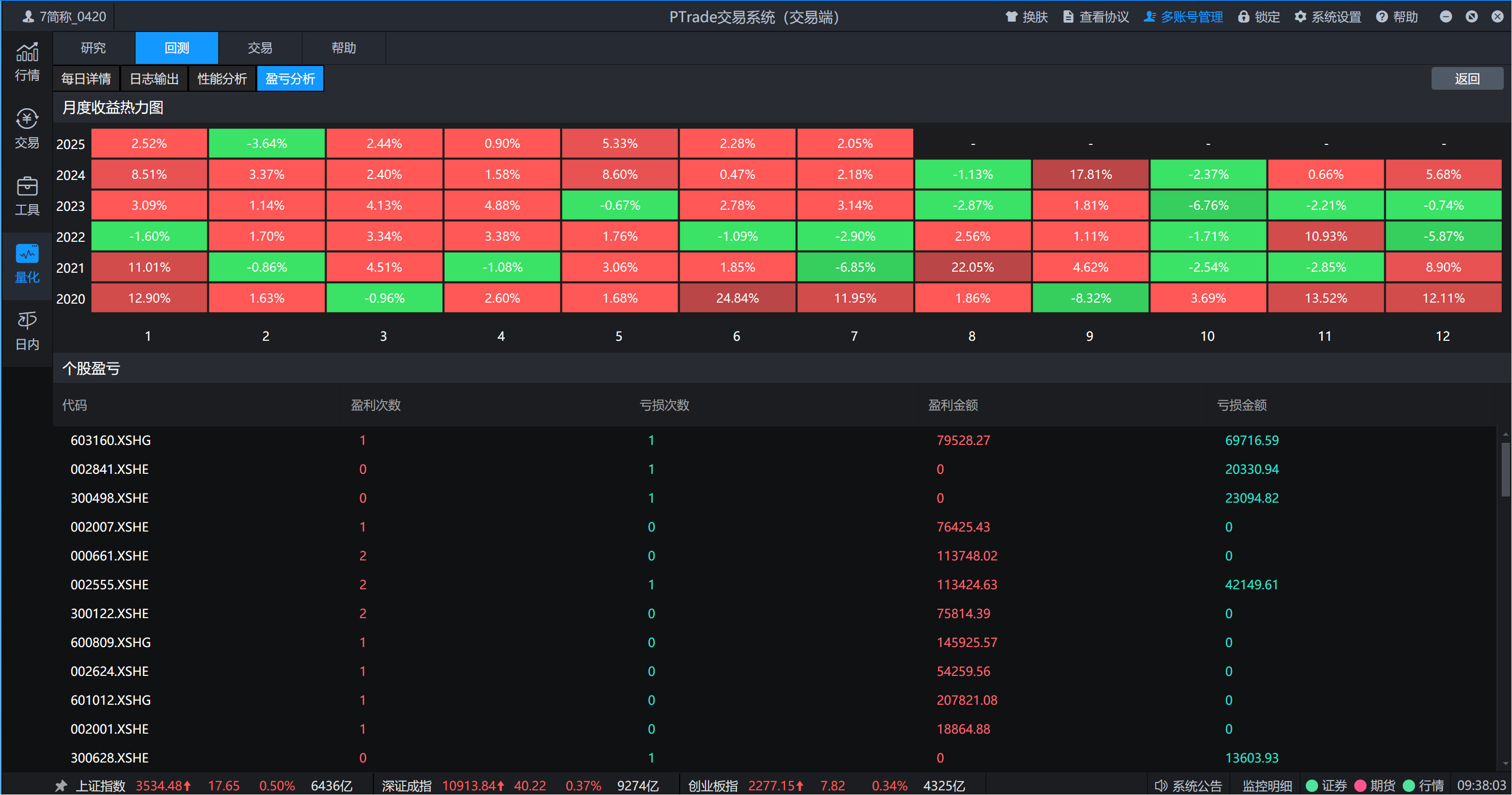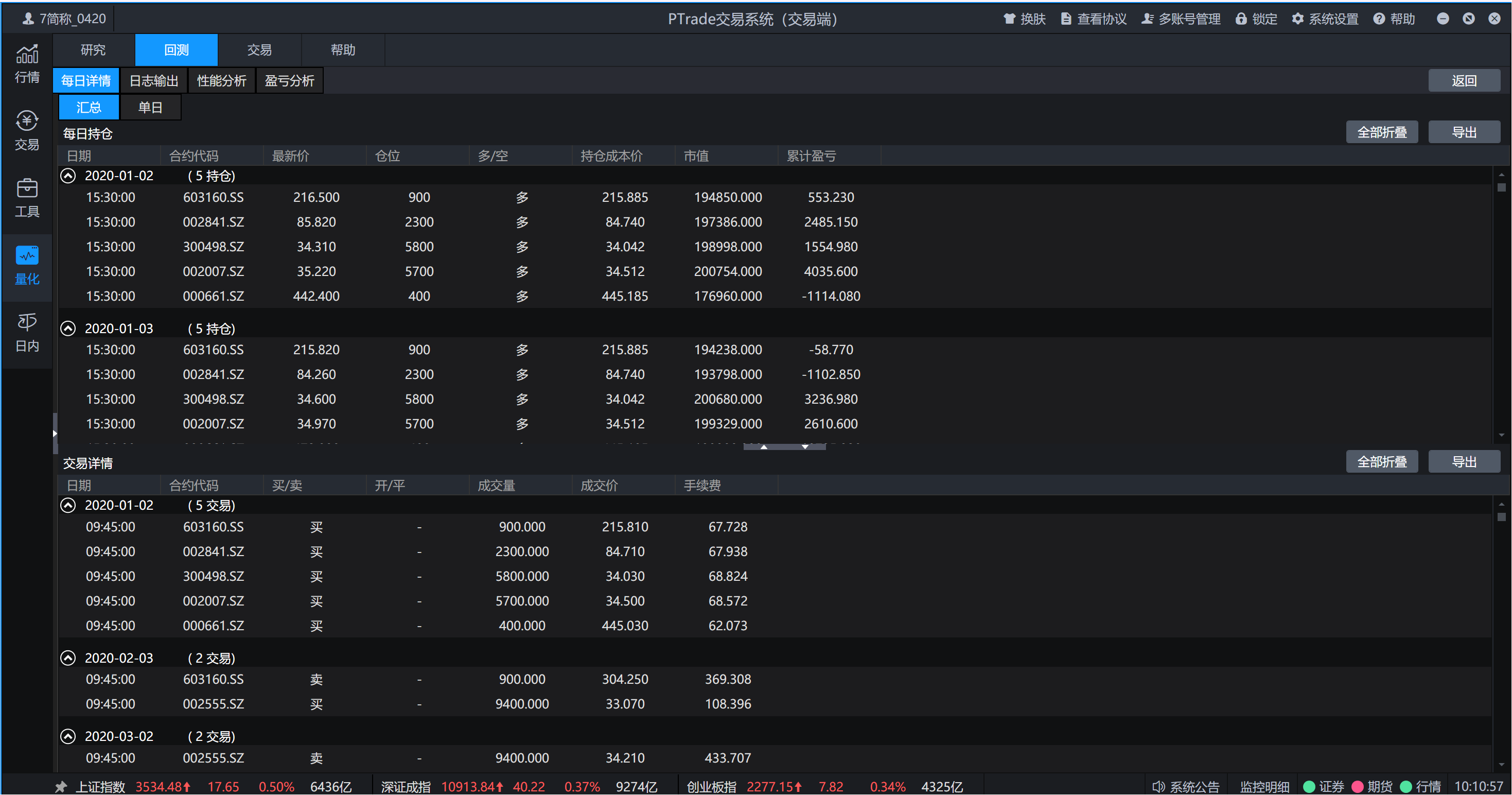ptrade量化策略之沪深300指数增强
本策略的核心是在沪深300股票池中选股,选择的股票都是市值比较大,业绩比较好的白马股,根据市场相对位置以及基本面因子来选择股票
·
本策略的核心是在沪深300股票池中选股,选择的股票都是市值比较大,业绩比较好的白马股,根据市场相对位置以及基本面因子来选择股票,每月调仓一次,总的手续费低,策略的容量比较大,比较适合资金量大的稳健投资者和上班族。
回测数据(2020.1.1-2025.7.10)如下:



*回测数据只作测试用,不代表未来实际收益
1、策略初始化配置
定义了持股数、股票池、市场位置、调仓函数等
g.buy_stock_count = 5 # 持股数
g.check_out_lists = [] # 股票池
g.market_temperature = "mid" # 市场位置
g.month = 0 # 记录月份
# 调仓函数
run_daily(context, my_trade, time='9:45')2、盘前处理
(1)计算市场位置
市场位置监控,获取沪深300指数过去220个交易日的收盘价,计算市场的相对位置,如果在0.2以下就是底部区域,0.9以上就是顶部区域,最近60日最高涨幅超过20%就是相对温和上涨位置。
def Market_temperature(context):
index300 = get_history(220, frequency="1d", field="close", security_list="000300.SS").close.tolist()
market_height = (np.mean(index300[-5:]) - np.min(index300)) / (np.max(index300) - np.min(index300))
if market_height < 0.20:
g.market_temperature = "low"
elif market_height > 0.90:
g.market_temperature = "high"
elif np.max(index300[-60:]) / np.min(index300) > 1.20:
g.market_temperature = "mid" (2)过滤科创北交、ST、停牌、当日涨停股票
all_stocks = get_index_stocks("000300.SS")
list = []
check_out_lists = []
final_list = filter_st_status(all_stocks)
final_list = filter_halt_status(final_list)
final_list = filter_deli_status(final_list)
for stock in final_list:
info = get_stock_info(stock)
if not (('ST' in info[stock]["stock_name"]) or
('*' in info[stock]["stock_name"]) or
('退' in info[stock]["stock_name"]) or
(stock.startswith('30')) or # 创业
(stock.startswith('68')) or # 科创
(stock.startswith('8')) or # 北交
(stock.startswith('4'))):
list.append(stock)(3)根据市场位置选股
低位:选择强现金流、扣非净利润为正的破净股,以roa/pb来排序
中位:选择营收翻倍高增的破净股,以roa/pb来排序
高位:选择pb3以上当前营收3倍高增、利润20%增长的成长股, 只用roa排序
选出6只股票
if g.market_temperature == "low":
check_out_lists = get_market_low(context, list)
elif g.market_temperature == "mid":
check_out_lists = get_market_mid(context, list)
elif g.market_temperature == "high":
check_out_lists = get_market_high(context, list)def get_market_low(context, stock_list):
df = get_fundamentals(stock_list, "valuation", fields=["pb"],
date=context.previous_date)
df = df[(df["pb"] > 0) & (df["pb"] < 1)]
if df.empty:
return []
list = df.index.tolist()
# print(list)
subtotal_operate_cash_inflow_df = get_single_fundamentals(context, list, "cashflow_statement", "subtotal_operate_cash_inflow")
net_profit_cut_df = get_single_fundamentals(context, list, "profit_ability", "net_profit_cut")
net_profit_grow_rate_df = get_single_growth_fundamentals(context, list, "income_statement", "net_profit")
roe_cut_df = get_single_roe_cut_fundamentals(context, list)
roa_df = get_single_roa_fundamentals(context, list)
df = pd.concat([subtotal_operate_cash_inflow_df, net_profit_cut_df, net_profit_grow_rate_df, roe_cut_df, roa_df], axis=1)
df["division"] = df["subtotal_operate_cash_inflow"] / df["net_profit_cut"]
df = df[(df["subtotal_operate_cash_inflow"] > 0) & (df["net_profit_cut"] > 0) & (df["net_profit"] > -15) & (df["division"] > 2) & (df["roe_cut"] > 1.5)]
if df.empty:
return []
filter_list = df["stocks"].iloc[:, -1].tolist()
pb_df = get_fundamentals(filter_list, "valuation", fields=["pb"],
date=context.previous_date)
stocks_pb = pb_df["pb"].tolist()
df["pb"] = stocks_pb
df["sort"] = df["roa"] / df["pb"]
df = df.sort_values(by="sort", ascending=False)
filter_list = df["stocks"].iloc[:, -1].tolist()
print(filter_list)
return filter_list[:6]def get_market_mid(context, stock_list):
# stock_list = ["601211.SS", "600036.SS"]
df = get_fundamentals(stock_list, "valuation", fields=["pb"],
date=context.previous_date)
df = df[(df["pb"] > 0) & (df["pb"] < 1)]
if df.empty:
return []
list = df.index.tolist()
subtotal_operate_cash_inflow_df = get_single_fundamentals(context, list, "cashflow_statement", "subtotal_operate_cash_inflow")
net_profit_cut_df = get_single_fundamentals(context, list, "profit_ability", "net_profit_cut")
net_profit_grow_rate_df = get_single_growth_fundamentals(context, list, "income_statement", "net_profit")
roe_cut_df = get_single_roe_cut_fundamentals(context, list)
roa_df = get_single_roa_fundamentals(context, list)
df = pd.concat([subtotal_operate_cash_inflow_df, net_profit_cut_df, net_profit_grow_rate_df, roe_cut_df, roa_df], axis=1)
df["division"] = df["subtotal_operate_cash_inflow"] / df["net_profit_cut"]
df = df[(df["subtotal_operate_cash_inflow"] > 0) & (df["net_profit_cut"] > 0) & (df["net_profit"] > 0) & (df["division"] > 1) & (df["roe_cut"] > 2)]
if df.empty:
return []
filter_list = df["stocks"].iloc[:, -1].tolist()
pb_df = get_fundamentals(filter_list, "valuation", fields=["pb"],
date=context.previous_date)
stocks_pb = pb_df["pb"].tolist()
df["pb"] = stocks_pb
df["sort"] = df["roa"] / df["pb"]
df = df.sort_values(by="sort", ascending=False)
filter_list = df["stocks"].iloc[:, -1].tolist()
print(filter_list)
return filter_list[:6] def get_market_high(context, stock_list):
df = get_fundamentals(stock_list, "valuation", fields=["pb"],
date=context.previous_date)
df = df[df["pb"] > 3]
if df.empty:
return []
list = df.index.tolist()
subtotal_operate_cash_inflow_df = get_single_fundamentals(context, list, "cashflow_statement", "subtotal_operate_cash_inflow")
net_profit_cut_df = get_single_fundamentals(context, list, "profit_ability", "net_profit_cut")
net_profit_grow_rate_df = get_single_growth_fundamentals(context, list, "income_statement", "net_profit")
roe_cut_df = get_single_roe_cut_fundamentals(context, list)
roa_df = get_single_roa_fundamentals(context, list)
df = pd.concat([subtotal_operate_cash_inflow_df, net_profit_cut_df, net_profit_grow_rate_df, roe_cut_df, roa_df], axis=1)
df["division"] = df["subtotal_operate_cash_inflow"] / df["net_profit_cut"]
df = df[(df["subtotal_operate_cash_inflow"] > 0) & (df["net_profit_cut"] > 0) & (df["net_profit"] > 20) & (df["division"] > 0.5) & (df["roe_cut"] > 3)]
if df.empty:
return []
df = df.sort_values(by="roa", ascending=False)
filter_list = df["stocks"].iloc[:, -1].tolist()
print(filter_list)
return filter_list[:6] (4)动量因子打分
动量因子评分,选择评分最高的5只股票,计算两个值:
年化收益率:250天的年化收益率
高R平方值:用于评估趋势的稳定性,高R平方值意味着价格变动更符合线性趋势,策略信号更可靠,筛选出趋势明显的股票,避免在波动大或无趋势的市场中交易。
def MOM(context, stock, days):
pre_date = context.previous_date.strftime('%Y%m%d')
df = get_price(stock, end_date=pre_date, frequency='1d',
fields=['close'], count=days)
y = np.log(df['close'])
n = len(y)
x = np.arange(n)
weights = np.linspace(1, 2, n)
slope, intercept = np.polyfit(x, y, 1, w=weights)
annualized_returns = math.pow(math.exp(slope), 250) - 1
residuals = y - (slope * x + intercept)
weighted_residuals = weights * residuals**2
r_squared = 1 - (np.sum(weighted_residuals) / np.sum(weights * (y - np.mean(y))**2))
score = annualized_returns * r_squared
return score
def Moment_rank(context, stock_pool, days, ll, hh):
score_list = []
for stock in stock_pool:
score = MOM(context, stock, days)
score_list.append(score)
df = pd.DataFrame(index=stock_pool, data={'score':score_list})
df = df.sort_values(by='score', ascending=False) # 降序
df = df[(df['score']>ll) & (df['score']<hh)]
rank_list = list(df.index)
return rank_list3、调仓逻辑
(1)卖出
卖出不在目标股票池中的股票
hold_list = list(context.portfolio.positions.keys())
for stock in hold_list:
if stock not in buy_stocks[:g.buy_stock_count]:
log.info("调出平仓:[%s]" % (stock))
close_position(stock)
else:
log.info("已持仓,本次不买入:[%s]" % (stock))(2)买入
根据可用资金平均分配买入
# 根据股票数量分仓
# 此处只根据可用金额平均分配购买,不能保证每个仓位平均分配
stocks = updatePositions(context)
position_count = len(stocks)
if g.buy_stock_count > position_count:
value = context.portfolio.cash / (g.buy_stock_count - position_count)
for stock in buy_stocks[:g.buy_stock_count]:
if stock not in stocks:
open_position(stock, value)这篇文章主要分享沪深300指数增强策略,主要的逻辑在市场位置判断以及选股逻辑上,适合资金量大的稳健投资者。
如果有不懂的,欢迎找我一起交流,加入量化交易大家庭
更多推荐
 已为社区贡献6条内容
已为社区贡献6条内容










所有评论(0)